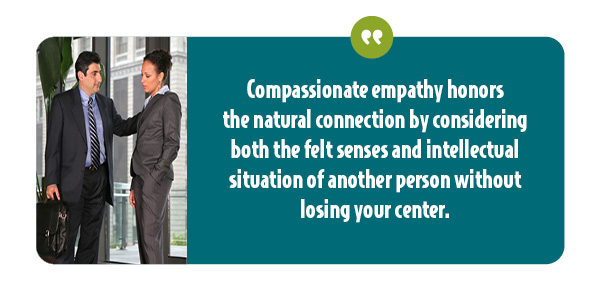Do you know what the three kinds of empathy are and how to express them? Empathy is a must-learn skill that brings more ease and understanding to your life and relationships!
When a student tells you they’re overwhelmed or your partner is working from home and is stressing—do you respond with empathy? Or do you react? Or how would you respond if your partner expressed fear, sadness, and anger telling you they lost their job, and it was right after you dipped into savings to build an addition to your house? The ideal would be to respond thoughtfully and empathetically, but many of us react.
The thing is, not all empathy looks and feels the same; just like not all sadness is the same; or happiness; or fear.
Estimated reading time: 6 minutes

Feel free to jump to what most resonates with you.
What Is the Definition of Empathy?
Can You Learn Empathy as an Adult?
Kinds of Empathy
Cognitive Empathy
Emotional Empathy
Compassionate Empathy
Empathy Tips for Practice
Being Authentic When Giving Empathy
Learn Empathy through Practical Application
Empathy Means to Lean In with Compassion
This is a topic we’re impassioned about at Heartmanity, especially because empathy is so integral to emotional intelligence (EQ), being compassionate, and connecting with the people you love and work with.
Think about the happiness of a weekend off work versus the joy of a wedding or the twisted pleasure of Schadenfreude, German for the enjoyment of another’s misfortune.
Empathy has different facets, too. In fact, empathy also comes from a German word, Einfühlung, meaning “feeling in.” And just as there are many ways to feel; there are multiple ways to experience empathy.
So let's begin with the basics: "What is the definition of empathy?"
From an emotional researcher's standpoint, it's "the ability to sense other people's emotions, coupled with the ability to imagine what someone else might be thinking or feeling."
From a human and vulnerability perspective and according to Brené Brown, "Empathy is communicating that incredible healing message of 'You're not alone.'"
The three types of empathy that psychologists have defined are: Cognitive, Emotional, and Compassionate.
As an aside, it’s worth noting that empathy is a relatively new idea and is still being defined by social and cognitive psychologists. As The Atlantic’s article “A Short History of Empathy” points out: “The term’s only been around for about a century—but over the course of its existence, its meaning has continually changed.”
If empathy is a murky concept to you, read our piece "What is Empathy and Why is it important?"
Empathy IS important. It is a cornerstone of emotional intelligence.
And the type of empathy that you express or experience matters as well.
Cognitive, Emotional, and Compassionate empathy all manifest in different ways. Reflecting on your own experiences at home, at work, or with friends and family, it probably won’t take long for you to notice the different types in your own life.
There are plentiful examples on TV, in politics, and in pop culture to draw from as well; however, many of them exhibit a lack of emotional intelligence, too. See if you can tell the difference between when a person is responding with empathy or not.
Deep Dive: "5 Ways to Use Empathy and Empathizing to Improve Any Relationship!"
Can You Learn Empathy as an Adult?
You might be wondering if you can still learn how to empathize even though you didn't learn it as a child. The answer is a resounding Yes!
Even if you have difficulty identifying your own emotions or picking up on the emotional cues of others, these are EQ skills that can be learned, just like driving a car. Remember how challenging it was when you first learned as a teen to drive?
The best way is to raise self-awareness and start paying attention to the energy, body language, and expressions of those around you. The first step is NOTICING.
Be encouraged: Not only can you learn it but our brain has all the hardware to support it.
We have mirror neurons for the purpose of reading others' emotions and standing in someone else's shoes. This ability to understand creates an emotional contagion enabling us to connect with another person's emotional experience.
It will take practice but we can draw a positive correlation between feeling empathic concern and our willingness to help others. Empathy is an aspect of being human. Therefore, it's completely possible to learn emotional intelligence skills, including empathy.
A recent study published in the Journal of Counseling Psychology shows that empathy training is effective. When you practice empathy, you build the emotional intelligence muscles and you get better at empathizing over time.
Dig in now to increase your skills.
KINDS OF EMPATHY

What Is Cognitive Empathy?
Cognitive Empathy Definition
Daniel Goleman, a renowned psychologist and the author of the 1995 book Emotional Intelligence says, “Simply knowing how the other person feels and what they might be thinking. Sometimes called perspective-taking.” Cognitive empathy means exercising a mental understanding of the person's experience.
What It's Concerned With
- Thoughts
- Reasoning
- Understanding
- Intellect.
Benefits of Cognitive Empathy
- Helps in negotiations.
- Immensely useful when logic is needed.
- Motivates other people.
- Increased understanding of diverse viewpoints.
- Ideal for virtual meetings.
Pitfalls of Cognitive Empathy
Interacting too much with logic can disconnect you from or ignore deep emotions; doesn’t put you in another’s shoes in a felt sense. Cognitive Empathy is about thought as much as emotion. It is defined as knowing, understanding, or comprehending on an intellectual level. As most of us know, understanding sadness is not the same thing as feeling sad.
Cognitive Empathy is about thought as much as emotion. It is defined as knowing, understanding, or comprehending on an intellectual level. As most of us know, understanding sadness is not the same thing as feeling sad.
If you arrived home upset about losing a job, and your partner responded with cognitive empathy, you probably wouldn't feel heard.
However, a doctor can look at a sick patient in emotional distress and try to understand the parts of the illness rather than dive into the patient’s emotions—cognitive empathy responds to a problem with brainpower.
An engineer turns his brain into high gear in stressful situations. You could say it’s the way some people are wired. Understanding emotions in terms of why they make sense for humans in certain situations is different than feeling another's emotions.
This type of empathy can be a huge asset in circumstances where you need to “get inside another person’s head” or interact with tact and understanding. We talk about using cognitive empathy as a leader in our blog “Emotional Intelligence and Empathy in Leadership.”
On the other hand, cognitive empathy is, in some ways, like mixing apples and oranges. To truly understand another person’s feelings, don’t you, in some sense, have to be able to feel them yourself? Therefore, those who respond with Cognitive Empathy can risk seeming cold or too detached.
Related topic: "What Is Emotional Intelligence?"
Enrich your life and relationships with:
our how-to workbook, "Real Empathy, Real Solutions: 4 Keys for Unlocking the Power of Empathy!

What Is Emotional Empathy?
Emotional Empathy Definition
Emotional empathy is “when you feel physically along with the other person, as though their emotions were contagious.” as stated by Daniel Goleman.
What It's Concerned With
- Feelings
- Physical sensations
- Mirror neurons
- Emotional or limbic brain.
Benefits of Emotional Empathy
- Helps in close interpersonal relationships.
- Extremely conducive to parenting.
- Useful in careers such as nursing, coaching, marketing, and HR.
- Motivates people to seek to understand.
- Promotes deeper connection between people.
Pitfalls of Emotional Empathy
Emotional contagion is more likely in emotional empathy and can be overwhelming for some people; a person can take on the feelings of another unnecessarily and it can also be inappropriate in certain circumstances.

Emotional Empathy, just like it sounds, involves directly feeling the emotions that another person is feeling. You’ve probably heard of the term “empath,” meaning a person with the ability to fully take on the emotional and mental state of another. The quote that comes to mind is: “I have a lot of feelings.”
This type of response might seem disconnected from the brain and thinking, but as Goldman points out, emotional empathy is actually deeply rooted in a human’s mirror neurons. All animals have neurons that fire in a certain way when they see another animal acting, making them relate to that action in their own body and brain. Emotional empathy does exactly that with the feelings someone experiences in reaction to a situation.
When your partner—or anyone you deeply love—comes to you in tears, it’s a natural response to feel that pull on your heartstrings. Like crying at a wedding or cringing when someone stubs their toe, it’s a deep-seated, gut reaction that often feels like a visceral human response. Connecting with another human in this way is intimate and can form a strong bond.
Like Cognitive Empathy, Emotional Empathy has its flip side. “One downside of emotional empathy occurs when people lack the ability to manage their own distressing emotions,” writes Goleman. “[This] can be seen in the psychological exhaustion that leads to burnout.” Feeling too much can make even small interactions overwhelming.For real-life examples of each kind of empathy, see "How to Talk to Someone with Empathy—and What to Avoid!"
What Is Compassionate Empathy?
Compassionate Empathy Definition
“With this kind of empathy, we not only understand a person’s predicament and feel with them but are spontaneously moved to help, if needed.” ~Daniel Goleman
What It's Concerned With
- Intellect
- Emotion
- Caring action
Benefits of Compassionate Empathy
- Considers the whole person.
- Inspires action from the listener.
- Useful for extending compassion to world events.
Pitfalls of Compassionate Empathy
Very few—this is the type of empathy that we’re most often striving for! With compassionate empathy, we can be the best version of our humanity.
The majority of the time, Compassionate Empathy is ideal.

Cognitive Empathy may be fitting for the workplace, monetary negotiations, or surgeon’s offices; Emotional Empathy may be the first response with children and for our loved ones; Compassionate Empathy strikes a powerful balance of the two. In fact, it could even be used today for your teen doing hours of schoolwork online and feeling overwhelmed during the school year or bored in the summer.
Feelings of the heart and thoughts of the brain are not opposites. In fact, they’re intricately connected.
When your employee or loved one comes to you with a problem or is in tears, you want to understand why they are upset. You also want to provide comfort by sharing in their emotional experience and hopefully helping the reintegration and healing. Due to the emotional contagion that emotions invoke, it can be a lot to handle!
Or the person could be struggling with physical pain and a touch of cognitive empathy may be needed.
Many of us skew to one side or the other: more thinking or more feeling; more fixing or more commiserating.
Compassionate Empathy is taking the middle ground and using your emotional intelligence to effectively respond to the situation with loving detachment.
We don't get sucked in and take on the person's burden or feelings. We balance mindfulness with compassionate caring and could be considered compassion when expressed genuinely. Depending on the situation, we can move in and out of all three types of empathy. The person's emotions will guide you to what is most effective.
Related topic: "The Art of Empathy: How to Show Empathy Without Saying Sorry."  Does your friend or spouse just need to be held? Does the situation call for quick action? Or sometimes just a silent presence so they're not feeling alone in their pain.
Does your friend or spouse just need to be held? Does the situation call for quick action? Or sometimes just a silent presence so they're not feeling alone in their pain.
Without either becoming overwhelmed by sadness or trying to fix things with logistics, compassion brings a mindful touch to tough situations.
The above three types of empathy are defined as foundational. However, you may hear other names, references, and uses of empathy, such as affective empathy (another way of identifying emotional empathy), somatic empathy (when we physically feel in our bodies another's experience), evaluative empathy, and perceptual empathy, which are forms of cognitive empathy.
Typically, these are unnecessary variances for most people and everyday use so we have not included them in this blog. How to choose what kind of empathy takes practice and integration.
EMPATHY TIPS for practice
|
Being Authentic When Giving Empathy
When I think of empathy, I often think of a teeter-totter.
Go too far into another person’s psyche and you risk losing yourself.
Avoid being authentically interested in the person's experience, and you are missing out on an integral part of the human experience.
Is too much feeling inappropriate? Too little, hurtful?
The truth is, not all situations are the same just like not all empathy types are the same.
Can you think of one example of each type of empathy in your own life? Probably more than one. Hopefully, you’ve encountered compassionate empathy at some point!
Any type of empathy takes emotional fitness—just like any balancing act. There is no better use of time than practicing empathy. When you find that sweet spot where you can empathize effectively, whether navigating a workplace hurdle or comforting a loved one, it is absolutely worth the work.
If you'd like to learn more about empathy, it's one of Heartmanity's specialties! Try out our popular workbook, Real Empathy, Real Solutions: 4 Keys to Unlocking the Power of Empathy.And if you enjoyed this blog, sign up for our newsletter; you'll get more life hacks to make your relationships and life sweeter.










